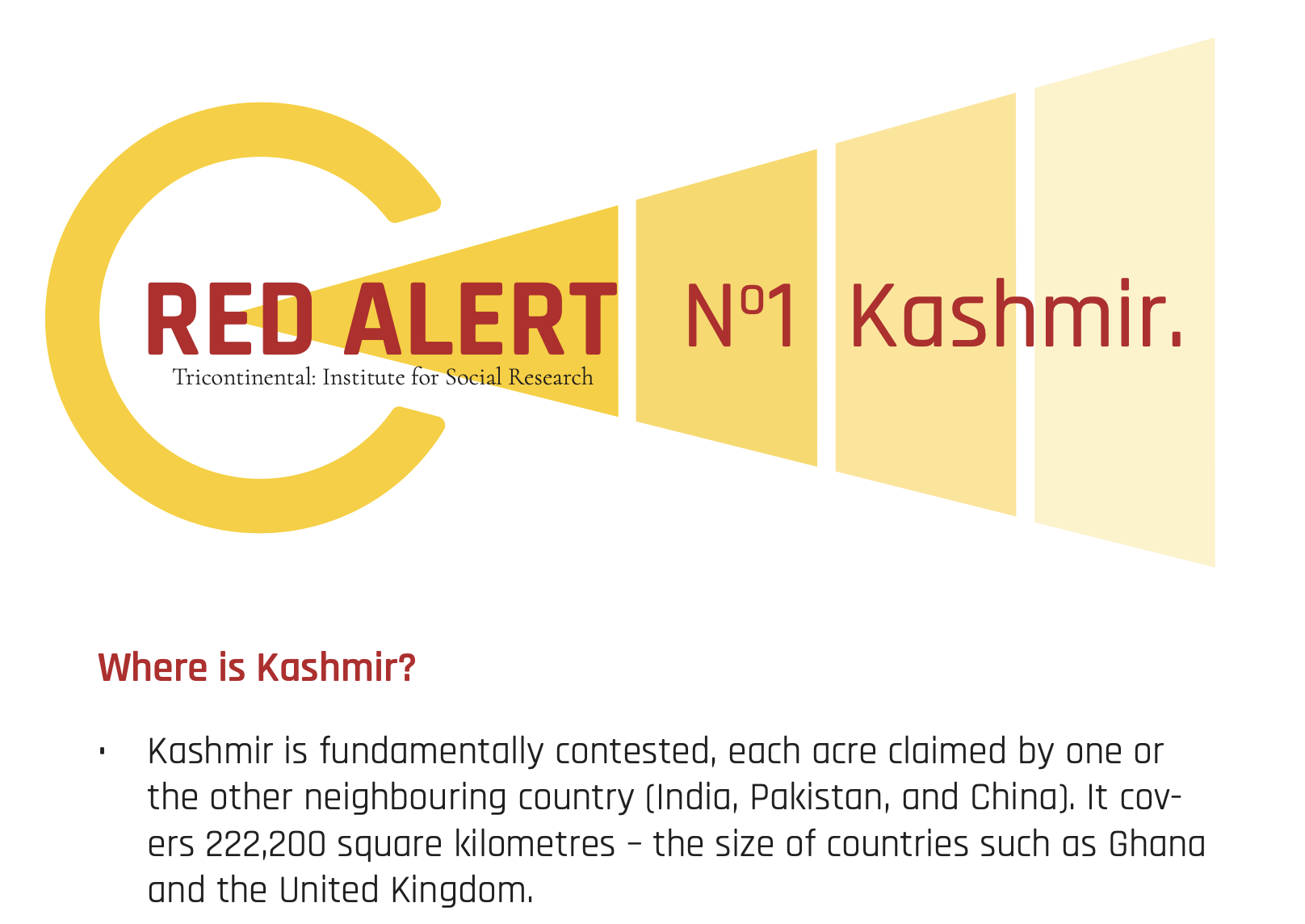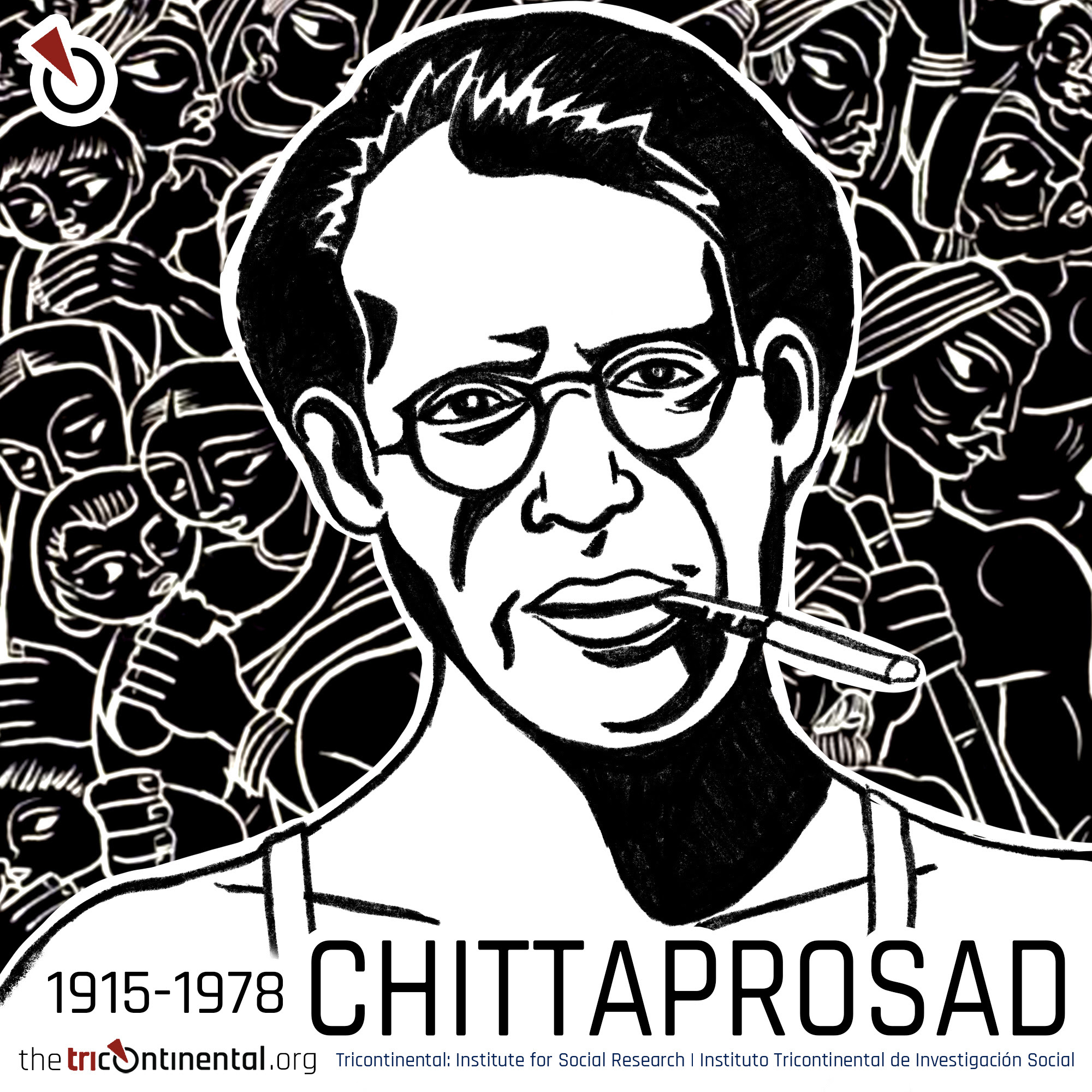As one door bangs shut in Kashmir, another opens in Argentina, writes Vijay Prashad.
 By Vijay Prashad
By Vijay Prashad
Tricontinental: Institute
for Social Research
 As one door sharply bangs shut in Kashmir, another opens in Argentina. That is the nature of our struggles. In 1859, Friedrich Engels wrote, “History often proceeds by jumps and zig-zags.” To imagine history as linear, moving in a progressive direction, is bewilderingly incorrect. It is romantic to believe either that history is conservatively circular – so that change is fundamentally impossible – or that history is progressively linear – so that everything improves in a scientific manner. Neither is plausible.
As one door sharply bangs shut in Kashmir, another opens in Argentina. That is the nature of our struggles. In 1859, Friedrich Engels wrote, “History often proceeds by jumps and zig-zags.” To imagine history as linear, moving in a progressive direction, is bewilderingly incorrect. It is romantic to believe either that history is conservatively circular – so that change is fundamentally impossible – or that history is progressively linear – so that everything improves in a scientific manner. Neither is plausible.
Human history is a struggle between the imagination for a better life and the constraints of the present. Some of these constraints are material, and some are social. Inadequate material conditions and the rigidities of class can hold back human progress.
The undemocratic attack on the people of Kashmir comes at the same time as the people of Argentina voted in their primary to overwhelmingly say that they are fed up with the politics of austerity (please see our Dossier no. 10 from November 2018 on the crisis in Argentina and the role of the IMF). Argentina’s population will vote again in October. By all indications, they will throw out President Mauricio Macri. Musicians and militants in Argentina have taken the old Italian partisan ballad, “Bella Ciao,” (“Goodbye Beautiful”) and refashioned it as a cry against neoliberalism and austerity “Macri Chau” (Goodbye Macri).
Dilma Rousseff, Brazil’s former president, reflected on the results of the primary in Argentina with the thought that this was a ‘light at the end of the tunnel for Argentina and for Latin America.”
 History might move in zig-zags, but in temporal terms it is bewildering. Large numbers of significant events seem to strike us at faster and faster rates. It is hard to keep up with the news, let alone follow what is going on in each country. Tragedies appear suddenly and the names of communities that are little known fly off our lips: The Yazidis! The Rohingyas! In the next instance, they are forgotten, only to be replaced by the next calamity. Even as events rush by, history seems to be at a standstill. Nothing really changes. Lives remain precarious, days seem repetitive. The combination of what appears to be the speed of change with the experience of stasis is what is disorienting.
History might move in zig-zags, but in temporal terms it is bewildering. Large numbers of significant events seem to strike us at faster and faster rates. It is hard to keep up with the news, let alone follow what is going on in each country. Tragedies appear suddenly and the names of communities that are little known fly off our lips: The Yazidis! The Rohingyas! In the next instance, they are forgotten, only to be replaced by the next calamity. Even as events rush by, history seems to be at a standstill. Nothing really changes. Lives remain precarious, days seem repetitive. The combination of what appears to be the speed of change with the experience of stasis is what is disorienting.
To provide a modest map to navigate some of these events, Tricontinental: Institute for Social Research will produce a regular “Red Alert,” a brief two-page assessment of key crises that can be easily printed out and distributed. The first – which is below – is on Kashmir. The PDF of this Red Alert #1: Kashmir can be downloaded here.

Where is Kashmir?
Kashmir is fundamentally contested, each acre claimed by one or the other neighboring country (India, Pakistan and China). It covers 222,200 square kilometers – the size of countries such as Ghana and the United Kingdom.
Approximately 17 million people live across this vast area, mostly in the regions controlled by India and Pakistan. The population of the Indian-held region alone is 12.5 million. Aksai Chin, controlled by China, is barren, significant mainly for a road that connects Tibet to Xinjiang.
What is the Permanent Problem of Kashmir?
The question of Kashmir is part of the unresolved business of the partition of South Asia in 1947. Until 1947, the region was under the control of a Hindu monarchy. The king was unwilling to accede to India. It was after armed raiders from Pakistan entered the Kashmir valley that he agreed to sign the Instrument of Accession. The most popular political movement in the region, the Jammu & Kashmir National Conference (under the leadership of Sheikh Abdullah), agreed to join the Indian Union as long as Kashmir’s autonomy was respected. The Indian Union has consistently whittled away at this autonomy.
On the day that the Indian army entered Kashmir (Oct. 27, 1947), India’s Prime Minister Jawaharlal Nehru sent a telegram to Pakistan’s Prime Minister Liaqat Ali Khan. In this telegram, Nehru wrote that Kashmir’s future “must be decided with the wishes of the people.” The standoff brought the dispute to the United Nations Security Council, which called for a plebiscite (resolutions 38 and 47).
Kashmir was divided by the war of 1947 between India and Pakistan. India and Pakistan have fought at least four major wars (1947, 1965, 1971, and 1999) as a result of this conflict, which has generated a permanent insurgency and a permanent militarization. There are estimated to be 600,000 Indian troops in Kashmir. Both countries have nuclear weapons.
Conditions in the Indian part of Kashmir have been atrocious for decades. Sober observers of the region have catalogued human rights abuses, including detentions, collective punishment, and torture of civilians. The UN High Commissioner of Human Rights’ reports from 2018 and 2019 show a shocking disregard for human rights by the Indian government in Kashmir. This violation of human rights and dignity is sought to be justified by the wild accusation that Kashmiris are terrorists.
What is the Current Crisis in Kashmir?
Two articles in the Constitution of India (1950) offered a fragile compromise towards the state’s autonomy. Article 370 conferred a special status on Jammu & Kashmir, allowing the state autonomy over certain key aspects of its governance. Article 35A prevented non-Kashmiri permanent residents from, among other matters, owning land in Kashmir
On Aug. 5, 2019, the right-wing Indian government of Narendra Modi and the Bharatiya Janata Party (BJP) invalidated articles 370 and 35A. This has been a demand of the Indian right-wing ever since 1948. On April 3, 2018, the Indian Supreme Court had said that Article 370 had acquired permanent status. Article 35A could not be removed because the Constituent Assembly had been dissolved in 1957. The legal basis to remove these two articles is not available. It will be challenged in the Indian courts.
Before the Modi government made this announcement in parliament, it sent 35,000 additional Indian troops into Kashmir. At the same time, it arrested all the major political leaders in Jammu & Kashmir. The legislative assembly had been dissolved in November 2018. The press was curtailed, and the Internet and phone services shut down.
The Indian government has unconstitutionally abolished the state of Jammu & Kashmir and divided it into two Union Territories, which will be governed from New Delhi rather than from Jammu & Kashmir’s capital Srinagar.
The Communist Party of India (Marxist) called the government’s actions the “murder of democracy and federalism.”
What is the Geopolitical Impact of the Kashmir Crisis?
The Indian government’s move on Jammu & Kashmir should not merely be seen as an internal matter. It is inextricably linked to the geopolitical atmosphere around the region.
The borders of China, India and Pakistan collide in Kashmir. All three countries have fought wars for parts of Kashmiri territory. India and Pakistan have fought four wars, while China and India fought one major war in 1962.
The main conflict here – since the 1940s – has been between India and Pakistan. Disagreements are deeply rooted in the political culture of each country. The rise of the far right in India has only inflamed the conflict further.
Wrapped up in the India-Pakistan conflict is the larger struggle between the United States and China. China opened its Belt and Road Initiative (BRI) to any country that would like to participate. India has refused partly because of its older history of animosity against China and partly because of its subordination to the United States. The United States is against the BRI; it is committed to the encirclement of China.
China’s BRI has developed in Pakistan and Nepal. The $46 billion China Pakistan Economic Corridor (CPEC) runs through Pakistani-controlled Kashmir along the Karakoram Highway to the Gwadar Port in Baluchistan. In 2017, China and Nepal agreed to build the Himalayan Economic Corridor. India’s Border Roads Organisation has been busy building roads along its border with China, from Kashmir to Bhutan to Nagaland.
In 2017, tensions rose in the Doklam region near the border between Bhutan, China, and India. Bhutan openly says that it does not want to get drawn into a China-India conflict. It wants to settle its border with China but is prevented from doing so by India.

The drawing above is from Chittaprosad, one of the great Communist artists of his day. “In my artwork, I represent the tradition of moralists and political reformers,” Chittaprosad wrote. “To save people means to save art itself. The activity of an artist means the active denial of death.” No wonder he drew that powerful picture for Kashmir in 1946.
Our comrades Maimoona Mollah, Kavita Krishnan, Jean Drèze and Vimal Bhai went to Kashmir on a fact-finding mission from August 9 to 13. They returned with a harrowing tale, whose report must be widely shared. “The whole of Kashmir is, at the moment, a prison, under military control,” they write.
The hospitals in Jammu & Kashmir fill up with injured civilians. Journalist Mudasir Ahmad visited the Lal Ded maternity hospital in Srinagar. He met Bilal Mandoo and Raziya, who were sitting with their stillborn baby. Stuck in the curfew, complications at the birth led to the death of their child. They are trapped in the hospital. “I feel like I’m choking here,” says Raziya. She speaks for all Kashmiris.
Vijay Prashad is an Indian historian, journalist, commentator and a Marxist intellectual. He is the executive director of Tricontinental: Institute for Social Research and the chief editor of LeftWord Books.
This article is from Tricontinental: Institute for Social Research.
Before commenting please read Robert Parry’s Comment Policy. Allegations unsupported by facts, gross or misleading factual errors and ad hominem attacks, and abusive language toward other commenters or our writers will be removed.

Re. Israel Shamir wrote an excellent piece a couple days ago on the situation in Kashmir, here is the link:
http://www.unz.com/ishamir/the-conflict-in-kashmir/
A very interesting and thought-provoking article – that history cannot be seen exclusively as circular or linear. This imaginative approach from Vijay Prashad is what is needed if world war three is to be avoided. The current state of the planet raises the question: why does humanity keep coming back to war, as we face a third global conflict in a century? It is important to find what is present in all war: a pattern. One thing present in every war is power. Manifested as interest it has been present in every conflict of the past – no exception. It is the underlying motivation for war. Eventually power leads every empire into the war it seeks to avoid, total defeat. But leadership deludes itself into thinking that fateful war can be avoided, limited in scale or even won. History always proves them wrong.
https://www.ghostsofhistory.wordpress.com/
Part 1:
This endless TERRORISM and GENOCIDE by the most evil COLONIAL pro-ISrael/Zionist HINDU MASS MURDERERS/RAPISTS/ROBBERS towa-rds the INDIGENOUS Muslim Kashmiris – is actually not just about religion, but also about TERRORIST ZioNAZI US/NATO-ISrael and their allies, including Modi/BJP here, conquering the whole HIMALAYAN MOUNTAIN RANGE, with Modi/BJP and ist founder and sponsor, the Hitler/NAZI-worshipping RSS, or Rashtriya Swayamsevak Sangh [National Volunteers Association – a core organization in the Hindutva (Hindu fascist) movement and network], targeting the ’Hindu Kush‘ Himalayan (HKH) region (but now, they support ISrael because of its RACISM, SUPREMACISM and FASICM towards its INDIGENOUS Palestinian Muslims/Catholics).
Because, the HUNDRED MILLION YEARS old ancestral HIMALAYAN RANGE, that spans across India, Pakistan, Afghanistan, Bangladesh, Bhutan, China, India, Myanmar, Nepal and Pakistan, and hidden underneath the new younger range – is actually full of ancient Volcanoes, rich in ZIRCON mineral rock, that consist URANIUM-THORIUM chemical elements, most essential for these ZioNAZI New World Order’s WAR INDUSTRY, including for constructing endless NUCLEAR WEAPONS and MILITARY SHIPS/FIGHTER PLANES/SPACESHIPS, until the end of days!! And this is the REAL reason why AFGHANISTAN is CONQUERED, and soon to be, all the nations in the HKH region, as desired by the anti-Islam/Muslim, anti-Sikh, anti-Christian, anti-woman, and anti-Dalit RSS/Modi-BJP, who also want to reclaim, falsely, their so-called Hindu Kingdom across the Himalayas! Especially, these ZioNAZI TERRORISTS are preventing any MUSLIM nations from possessing and building their own NUCLEAR WEAPONS and MILITARY SHIPS/FIGHTER PLANES/SPACESHIPS!!
*Kumpulan Pejuang Kemerdekaan Bangsa Orang Asal/Pribumi Melayu Malaysia (Malaysian Indigenous Malay Peoples Liberation Group).
Motto:
Berjuang untuk KEMERDEKAAN Bangsa Orang Asal/Pribumi Melayu Malaysia dari Penjajahan Parti Anti-Islam/Anti-Melayu DAP, yang ditaja oleh Pengganas-pengganas ZIONIS/MOSSAD-ISRAEL, yang amat rasis, ganas, perasuah dan rakus, yang telah menguasai Rejim Malaysia (PH) yang baru dan perasuah [Fighting for the LIBERATION of Malaysian Indigenous Malay Peoples from the extremely racist, violent, corrupted and greedy Colonization by the TERORISTS‘ ZIONIST/MOSSAD-ISRAEL-sponsored Anti-Islam/Anti-Malay DAP Party, which controls the new most corrupted Malaysian regime (PH party)]!
This “crisis” in Argentina was predictable when they elected Macri. He did exactly what his critics expected. Many people like myself were amazed that the people of Argentina returned to this failed path so quickly after their last economic meltdown,. The last time they ran the economy into the ground wasn’t that long ago . The voters of Argentina deserve what is happening now. Look at Argentina’s history. It isn’t called a Deep State but the Right has power and do not suffer from these actions. It’s the people who end up paying for it on the way up and on the way down as well and lose another generation of growth. The left has no discipline and no majority. They can’t produce leaders and if they do maybe you will have another “Dirty War”, The people are fickle , they want lollipops and the Left can’t deliver but they will have to clean up the mess then it will happen again. Believe it. As for Kashmir, like Palestine and the creation of the State of Israel and the artificial border between Iraq and Kuwait the UN created the situation that is manifest today. The UN had no answers, they just had to wrap things up with a nice tidy bow and this crisis like Saddam invading Kuwait and Israel annexing the West Bank were the hidden Devil in the details, . We see these deals of convenience today like in Hong Kong returning to China in stages like it’s all just going to work out. . You want History, it’s a legacy from the British Empire. In Kashmir, India is stronger, the Right is ascendant, Pakistan has to fight or counter somehow like they have in the past or India takes it. No zig-zags here , This is business as usual.
Very readable account by Perry Anderson of why India is a problem child of the world and will remain so until the Upper Caste Hindus (who’ve been addicted to power for thousands of years) keep ruling the roost:
https://www.lrb.co.uk/v34/n13/perry-anderson/gandhi-centre-stage
https://www.lrb.co.uk/v34/n14/perry-anderson/why-partition
https://www.lrb.co.uk/v34/n15/perry-anderson/after-nehru
Behind a paywall, but more recent, and shows again how India’s class (read caste) problems are chronic and not the result of authoritarian leader du-jour:
https://www.nybooks.com/articles/2019/07/18/indira-gandhi-long-undeclared-emergency/
Let Kashmir be it’s own country, please!
Have always thought of the similarities between the India and Kashmir and Palestinians and the Israel. The suppression of the Muslim Kashmiris and the Palestinian Arabs. Even reports that the Israelis serve as advisors and provide assistance to the Indian Government in this suppression. In both cases self determination was and is suppressed, and both Governments show disdain and disregard for international law or norms of civilized behavior. In both cases we are on the side of the disdainers and disregarders
I was working in Kashmir in the mid 80-ties. It was relatively prosperous part of the democratic India.
The “insurgency” in 1988 brought it to a Pakistani (military dictatorship) chaotic level and destroyed the living standard of the middle class.
Indian government has never had good relationship with its neighbors. Indian foreign polocy is rooted in antagonizing Bhutan, Nepal, Bangladesh, sri Lanka and Pakistan. But it has good relationship with the murderous Myanmar and israel. Bjp supporters are essentially worse than Nazis because they are so many of them the West actually would be better off working together with Muslim countries who are not as primitive. In India the caste mentality is strong and population wise there are manyHindu extremists.
The UN Security Council will hold a meeting on the situation around the autonomy of the Indian state of Jammu and Kashmir Aggravation in Kashmir: Russia and China did not agree on positions
Aggravation in Kashmir: Russia and China did not agree on positions
Israel Shamir wrote an excellent piece a couple days ago on the situation in Kashmir.